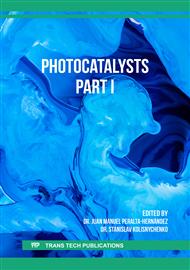[1]
Shen, S., Kronawitter, C., and Kiriakidis, G. An Overview of Photocatalytic Materials. Journal of Materiomics, 2017, 3(1): 1-2.
Google Scholar
[2]
Schneider, J., Bahnemann, D., Ye, J., Puma, G.L., and Dionysiou, D.D. Photocatalysis: Fundamentals and Perspectives. Royal Society of Chemistry. (2016).
Google Scholar
[3]
J. Sundaraam, O. N. B., Meena, P., Veeravazhuthi, V., and Selvan, K. T. Thin Film Techniques and Applications. New Delhi: Allied publishers PVT. LTD. (2004).
Google Scholar
[4]
Hussin, R., Choy, K. L., and Hou, X. Enhancement of Crystallinity and Optical Properties of Bilayer TiO₂/ZnO Thin Films Prepared By Atomic Layer Deposition. J Nanosci Nanotechnol, 2011, 11(9): 8143-8147.
DOI: 10.1166/jnn.2011.5086
Google Scholar
[5]
Fallah, M., Zamani-Meymian, M. R., Rahimi, R., and Rabbani, M. Effect of Annealing Treatment on Electrical and Optical Properties of Nb Doped TiO₂ Thin Films As A TCO Prepared by Sol-Gel Spin Coating Method. Applied Surface Science, 2014, 316: 456-462.
DOI: 10.1016/j.apsusc.2014.08.029
Google Scholar
[6]
Pérez-Larios, A., Lopez, R., Hernández-Gordillo, A., Tzompantzi, F., Gómez, R., and Torres-Guerra, L.M. Improved Hydrogen Production from Water Splitting Using TiO₂–ZnO Mixed Oxides Photocatalysts. Fuel, 2012, 100: 139-143.
DOI: 10.1016/j.fuel.2012.02.026
Google Scholar
[7]
Mathews, N. R., Morales, E. R., Cortés-Jacome, M. A., and Toledo Antonio, J. A. TiO₂ Thin Films – Influence of Annealing Temperature on Structural, Optical and Photocatalytic Properties. Solar Energy, 2009, 83(9): 1499-1508.
DOI: 10.1016/j.solener.2009.04.008
Google Scholar
[8]
Xu, L.M., Yang, M., Li, X.Y., Hu, P., and Li, S.W. Effect of Growth Temperature on Ferromagnetism in Mn: TiO₂ Thin Film Grown on SrTiO₃: Nb Substrate. Scripta Materialia, 2010, 63(1): 113-116.
DOI: 10.1016/j.scriptamat.2010.03.027
Google Scholar
[9]
Schoeppner, R. L. D., Bahr, F., Jin, H., Goeke, R. S., Moody, N. R., and Prasad, S. V. Wear Behavior of Au–ZnO Nanocomposite Films for Electrical Contacts. Journal of Materials Science, 2014, 49(17): 6039–6047.
DOI: 10.1007/s10853-014-8326-9
Google Scholar
[10]
Shei, S. C., Lee, P. Y., and Chang, S. J. Effect of Temperature on The Deposition of ZnO Thin Films by Successive Ionic Layer Adsorption and Reaction. Applied Surface Science, 2012, 258(20): 8109-8116.
DOI: 10.1016/j.apsusc.2012.05.004
Google Scholar
[11]
Malek, M.F., Mamat, M.H., Khusaimi, Z., Sahdan, M.Z., Musa, M.Z., Zainun, A.R., Suriani, A.B., Md Sin, N.D., Abd Hamid, S.B., and Rusop, M. Sonicated Sol-Gel Preparation of Nanoparticulate ZnO Thin Films with Various Deposition Speeds: The Highly Preferred C-Axis (0 0 2) Orientation Enhances The Final Properties. Journal of Alloys and Compounds, 2014, 582: 12-21.
DOI: 10.1016/j.jallcom.2013.07.202
Google Scholar
[12]
Chopra, K. L. and Das, S. R. Thin Film Solar Cell. New York: Plenum Press. (1983).
Google Scholar
[13]
Chen, Y., Zhang, C., Huang, W., Yang, C., Huang, T., Situ, Y., and Huang, H. Synthesis of Porous ZnO/TiO₂ Thin Films with Superhydrophilicity and Photocatalytic Activity via a Template-Free Sol-Gel Method. Surface and Coatings Technology, 2014, 258: 531-538.
DOI: 10.1016/j.surfcoat.2014.08.042
Google Scholar
[14]
Naseri, N., Yousefi, M., and Moshfegh, A. Z. A Comparative Study on Photoelectrochemical Activity of ZnO/TiO₂ And TiO₂/ZnO Nanolayer Systems Under Visible Irradiation. Solar Energy, 2011, 85(9): 1972-1978.
DOI: 10.1016/j.solener.2011.05.002
Google Scholar
[15]
Bel Hadjltaief, H., Ben Zina, M., Galvez, M.E., and Da Costa, P. Photocatalytic Degradation of Methyl Green Dye in Aqueous Solution Over Natural Clay-Supported ZnO–TiO₂ Catalysts. Journal of Photochemistry and Photobiology A: Chemistry, 2016, 315: 25-33.
DOI: 10.1016/j.jphotochem.2015.09.008
Google Scholar
[16]
Bai, L., Kou, G., Gong, Z., and Zhao, Z. Effect of Zn and Ti Mole Ratio on Microstructure and Photocatalytic Properties of Magnetron Sputtered TiO₂–ZnO Heterogeneous Composite Film. Transactions of Nonferrous Metals Society of China, 2013, 23(12): 3643-3649.
DOI: 10.1016/s1003-6326(13)62912-x
Google Scholar



